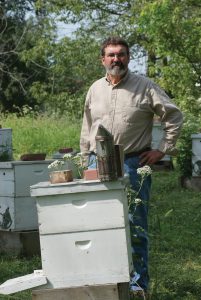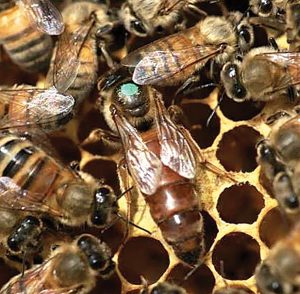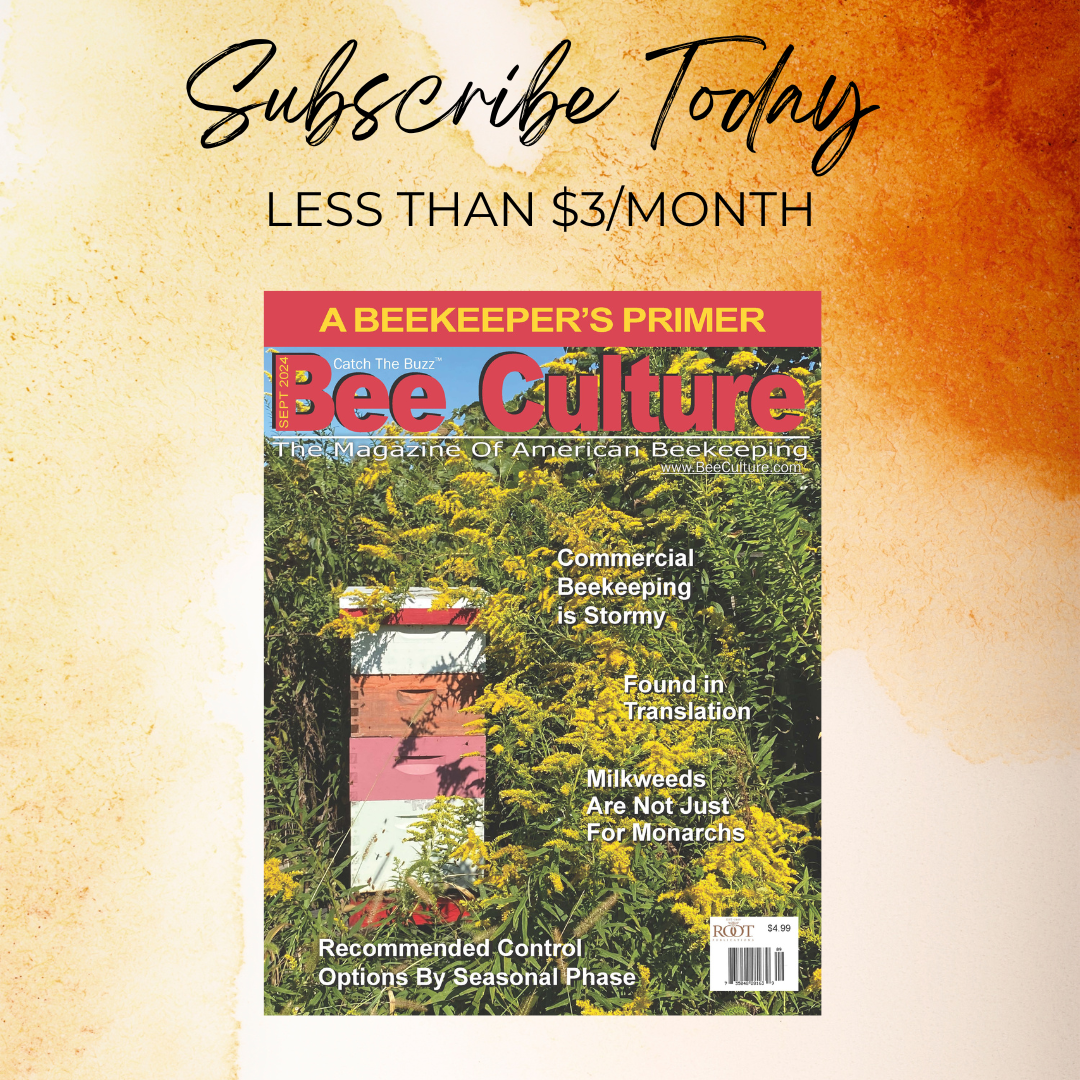Got a Question?
By: Phil Craft
 A beekeeper in Kentucky writes:
A beekeeper in Kentucky writes:
Is it ok to leave supers on hives during the Winter?
Phil replies:
Yes, it is quite acceptable to leave a honey super on top of the hive through the Winter; beekeepers frequently do this. Since the purpose is to ensure adequate food for the Winter, remember to remove queen excluders, if any. As winter progresses, the cluster will move into the upper brood box and then, if necessary, into the super as the bees consume the honey below. A queen excluder between brood box and super would prevent the cluster from reaching the extra food stored there, since the queen cannot go through the excluder.
There are a few issues to keep in mind before leaving supers on all Winter. If you treat in the Fall with a miticide which is not labeled for use with honey supers in place, you’ll need to remove them all prior to treating. Otherwise, you cannot later use the comb in those frames to store honey meant for human consumption. Frames of honey which you intend to return to the hive after treatment will have to be protected in the meantime from wax moths and small hive beetles. If you have enough available space, a freezer is excellent for storing these frames of honey.
Another consideration is what happens inside the honey super in the Spring. As the earliest blooms emerge, the cluster will be in the top box of the hive where the queen will begin to lay eggs and the colony to rear brood – all part of the spring cycle. Your honey super will have become an auxiliary brood box. Not a problem if you’re content to let it continue as such, but if you want to return it to its original function as honey super, you’ll need to take some management action. A simple solution is to allow the bees to continue to rear brood there for the time being. Colonies in build up mode can always use a little more space for the kids, and it may help to reduce the swarming urge. As the season progresses and the time comes to add honey supers, place additional supers above the overwintered one with a queen excluder separating all supers from the deep brood boxes. The brood in the overwintered super will emerge, the queen will be unable to reach the frames to lay more eggs, and the bees will begin to fill the empty cells with nectar. Transformation accomplished. Of course, some beekeepers prefer not to harvest honey from cells in which brood was once reared. The presence of brood darkens the wax which, in turn, darkens any honey later stored there. This is another case in which there is no right or wrong answer, only differences in management style and honey preference. I’ve always liked mine dark.
A beekeeper from Nevada writes:
Your column Ask Phil is the first thing I read when I get my copy of Bee Culture, and enjoy it very much.
My question is about queen excluders, I see on YouTube several videos condemning queen excluders. The videos show bees unable to get through the excluder. And I briefly put one on one of my hives and found dead bees stuck in the excluder and drones laying on the excluder. I don’t think I will use them even though I just bought eight of them.
What are your thoughts on excluders?
Phil replies:
As far as I know, I have never appeared on any YouTube videos, but if I had, they most certainly wouldn’t show me maligning queen excluders. I view a queen excluder in the way a woodworker might regard an old fashion block plane in his woodshop. It’s a tool which probably doesn’t get used every day, but for certain jobs it’s just the thing.
I wrote about queen excluders in my June 2014 Bee Culture column. In brief, when placed between brood boxes and supers, they allow workers access to the honey supers, but prevent the larger queen from entering and laying eggs there. For this purpose, they’re quite effective, and there are several situations in which they can be useful. Many beekeepers put them on three or four weeks before harvesting honey to ensure that no new eggs will be laid during the time it takes for any brood in the honey supers to emerge. Excluders can also be used to isolate a hard to find queen when re-queening or making splits. Some beekeepers keep them on as long as there are supers on the hive. Those who dislike them argue that they damage bees’ wings, encourage swarming, or act as honey excluders. I am not aware of any research to support the first two contentions. Some studies do show that queen excluders reduce the amount of honey stored in supers, but in my experience this is minimal, and well worth not having to deal with brood in my supers when extracting. In the article from June I talked about steps which can be taken to encourage bees to utilize honey supers even with an excluder in place. Whether it is more important to maximize honey production or to prevent the honey in the supers from darkening and contamination from brood is a personal preference.
However, you bring up a point not addressed in my earlier column: the issue of drones getting trapped in queen excluders. Drones, like queens, are larger than the spacing between the excluder wires. If there is no drone brood in your honey supers, this should not be a problem. On the other hand, if drone brood is present, the drones will get stuck as they try to pass through the excluder. This situation can arise if the queen got into the honey supers before the excluder was installed or if the beekeeper (as I sometimes do) moved frames of honey containing previously laid drone brood into the hive above the excluder. My inclination would be to ignore a few stuck drones. If there were enough to seriously clog the queen excluder, a simple solution would be to place a spacer (a small piece of wood would work) between two of the honey supers to provide the drones an alternative exit. That would basically create an upper entrance such as I discussed in my recent November column.
Even if you decide not to use queen excluders routinely in your supered hives, I wouldn’t get rid of all eight. You might very well find them useful in the right circumstances.
(Bee Culture readers: in the above question and answer, I referenced the June and November issues. If you do not have those back issues, contact me and I will email copies of the columns to you.)
A beekeeper in Kentucky writes:
I had a small colony of bees last Fall, so I decided to put them inside of a building with heat for the Winter. I would move them outside when temperatures got 50 or better. I have 20+ hives, so this year I was going to start marking queens, but have never marked one before. It was a nice day Saturday, I had this hive outside, so I thought it’s a nice day to try marking a queen. The first frame I pulled up, I saw the queen – this is going to be easy – and then out of corner of my eye I saw another queen on the next frame. Two queens, just a bee space apart! I marked both queens, and closed up the hive. About one hour later, I noticed bees flying in circles in front of the hive. I looked down and saw a queen with a green dot on the ground – one of my newly marked queens. I moved the queen just outside the entrance, and back into the hive she goes. How long do you think that two queens have been in that hive? I don’t think it has sat outside more than three days in a row since November. Did I do such a pretty job on marking one, which caused the other to be jealous, so she tried to run off?
Phil replies:
I am sure that both queens have been in the hive since at least early last Fall, the most recent time when conditions were favorable for rearing a new queen. As for the simultaneous presence of two queens, we’ve all been conditioned by beekeeping classes and grade school biology teachers to believe that there can be only one queen at a time. We’ve seen the nature documentaries of queens stinging rivals to death in their cells to establish supremacy in the hive. But that isn’t always the way it happens.
Bees produce three different types of queen cells in response to three different sets of conditions in the hive. In a teeming hive during a nectar flow, they may build swarm cells to provide the colony with a successor after the old queen leaves with a significant proportion of the colony to find other quarters and establish a new hive. In the event of the sudden loss of a queen, they produce emergency cells in what, if they possessed human emotions, would be a panicked attempt to keep the colony alive. Supersedure cells appear when there is a functioning queen in the hive, but the bees sense that she is failing. Commonly, this occurs when her ability to produce queen pheromones declines with age and instinct impels the colony to provide for the future by supplying a successor. The fight to the death scenario only occurs when multiple virgin queens emerge from their cells at about the same time, either as part of the swarming process or in the case of emergency queens. The supersedure of an aging queen by her royal daughter is much more civilized, with both queens co-existing for a period of time – sometimes for quite a long time – as you found in your weakened hive.
I’m certain that one of the queens you saw was a supersedure queen, and the other her mother. The mother’s end will eventually be determined and carried out by the workers. However, unlike a swarmed hive or one in which the queen has suddenly died, this colony has time on its side. In this case, two is better than one. I suspect that if she does not perform to the required standards, she will disappear and the old queen live on a while longer to produce another successor.
 I suspect that the situation you encountered occurs more often than we realize. The only way I can tell when a supersedure has taken place in my own bee yard is by finding an unmarked queen in a hive which my written notes record as containing one I had marked. I know then that, either the old queen was superseded, or the colony swarmed. The strength of the colony, the time of year, and the number of queen cells may help me determine which, or I may never know. This is the major reason I mark queens: to make me aware when they are replaced, which helps me keep up with genetic changes in the hives. (I’m glad you decided to try marking and had a successful first attempt.) Even when I realize that a queen has been replaced, I am not likely to notice if the hive contains, not one, but two. After all, we tend to see what we look for, and after finding one queen in a hive, we quit looking because that’s all we expect to see.
I suspect that the situation you encountered occurs more often than we realize. The only way I can tell when a supersedure has taken place in my own bee yard is by finding an unmarked queen in a hive which my written notes record as containing one I had marked. I know then that, either the old queen was superseded, or the colony swarmed. The strength of the colony, the time of year, and the number of queen cells may help me determine which, or I may never know. This is the major reason I mark queens: to make me aware when they are replaced, which helps me keep up with genetic changes in the hives. (I’m glad you decided to try marking and had a successful first attempt.) Even when I realize that a queen has been replaced, I am not likely to notice if the hive contains, not one, but two. After all, we tend to see what we look for, and after finding one queen in a hive, we quit looking because that’s all we expect to see.
As to one of your queens feeling jealous, I think that’s an exclusively human emotion. However, when showing off my observation hive to children, I sometimes point out the marked queen and tell them that the she is the only one who gets to wear makeup. Perhaps in marking one of your queens you smudged her makeup so that she got embarrassed and walked out.






